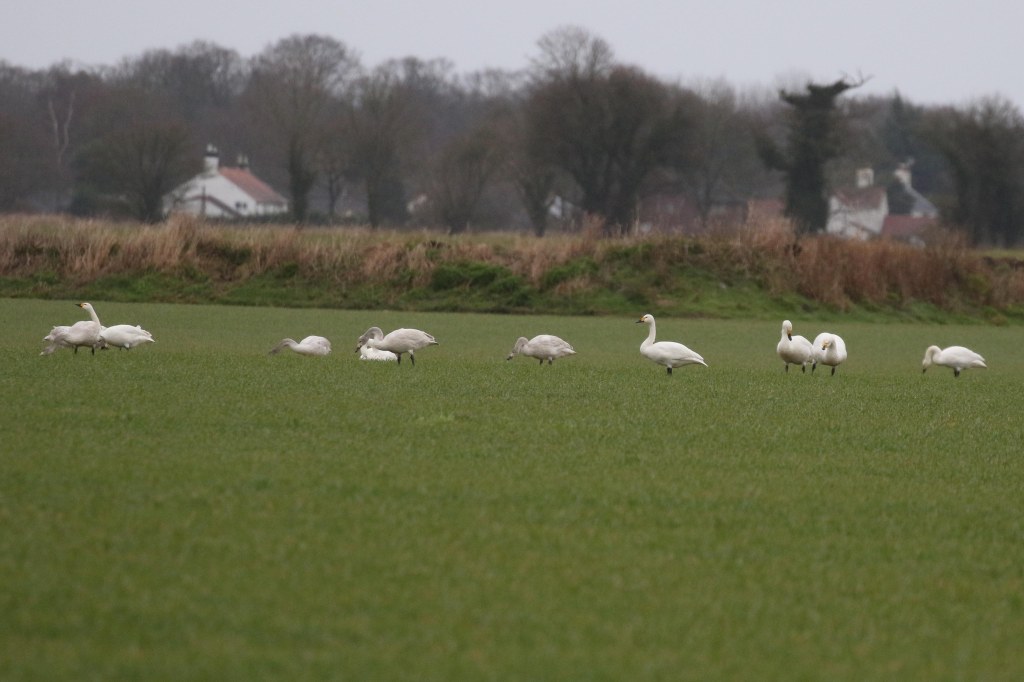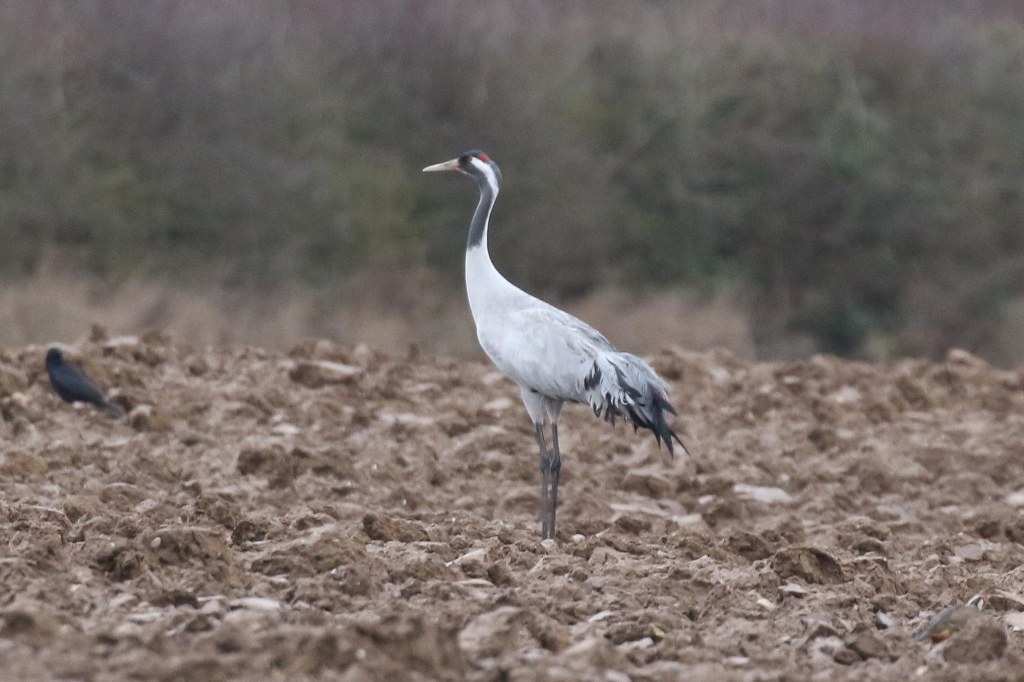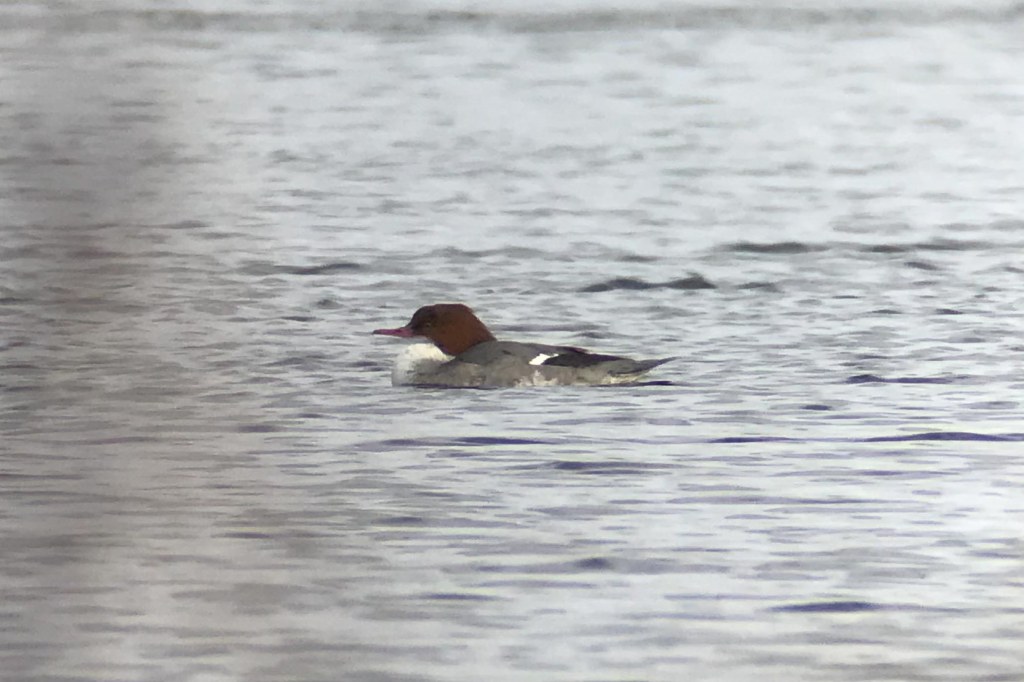Day 3 of a three day Winter Tour today, our last day. It was rather wild and windy, but helpfully the rain cleared through earlier than forecast and most of the morning was dry. The afternoon was meant to be bright with one or two showers but turned out to be the other way round – at least there were some dry periods just when we needed them. We spent the day exploring the Broads.
It was raining as we drove down, so we started with a drive round to look for swans. Thanks to a tip off from one of the locals who was with us for the tour, we knew exactly where to look this morning, which made matters a lot easier. As we drove up a rather narrow minor road, we could already see a small herd of swans in one of the fields. We parked alongside and got out, and discovered it had already stopped raining.

Even better, it turned out to be a mixed herd – 22 Bewick’s Swans and 5 Whooper Swans. It is always great to see the two species side by side. As well as being able to appreciate the big size difference, we could see the longer neck of the Whoopers and the different patterns of yellow on their bills, blunt on the Bewick’s Swans.

That was a great start to the day. After studying the swans for a while, we decided to move on and try our luck looking for Cranes. We drove round to an area where they have been feeding and as we pulled up at our first stop by a recently cut strip of maize a huge flock of Woodpigeons erupted from the ground. As they dispersed, we realised there were three Common Cranes in the ploughed field right in front of us!
We scanned from the minibus at first, so as not to flush them. There were another six Cranes in the next field back too. Eventually the original three took off, one landed with the others but a pair kept going, over the wood beyond and dropped down behind.

Now the Cranes were further back, we could get out. Setting up the scopes, we had a good view of the remaining seven in scopes. We could see the red patch on the top of the head of the adults. Three together were a family party, accompanied by their browner juvenile from summer 2021.
Now we noticed another 15 Cranes flying in from the north. As they got closer, we could hear them bugling. Most dropped down behind the wood, but two came in and landed with the birds still on the ground – amazing to watch as they stalled and put their legs down as they came in.
Having enjoyed great views of the Cranes here, we drove round to see where the others had landed. At first they were in a stubble field on high ground, and difficult to see, but we drove round behind them and they had walked out into a ploughed field, 17 together now. We watched them from the minibus, strutting around, picking at the ground. One found a piece of maize, and was chased by several others keen to steal the morsel.

There had been a report of the Red-necked Grebe again at Ormesby Little Broad earlier in the week, where we had seen it last month. We decided to have a look, as we would be sheltered from the wind there.
As we walked in along the path, we heard two Kingfishers calling. One flew off ahead of us along the ditch by the path, a flash of electric blue, and as we got round the corner, we had a brief view of one perched on an overhanging branch before it disappeared back through the trees.
From the platform at the end, we could see several Great Crested Grebes but no sign of the Red-necked Grebe. There were a few Goldeneye too, some smart drakes with white cheek patches. A Sparrowhawk shot across low over the water into the trees the other side. Shortly afterwards it came back out again and disappeared into the trees in the corner. A spot of blue in the trees at the back caught our eye – a Kingfisher was perched low in the trees, back onto us, showing of its bright back streak.
Someone else came out to the platform and told us he had seen a Goosander looking through the trees from the path on his way out. We looked as we made our way back, but couldn’t see anything. It was hard to see all the water through the trees, so we continued out onto the bridge by the road and scanned from there. Now we could see the Goosander, a redhead female, preening on the water along the edge of the trees. We had a good view in the scopes. A Water Rail squealed from reeds.

From the bridge, we could see across to Filby Broad on the other side of the road. It was very choppy, exposed to the wind that side. We could see a large raft of Common Pochard, all males, and lots more Goldeneye over towards the back.
The Red-necked Grebe was commuting between here and Rollesby Broad last month, so we decided to swing round via there to see if it might have moved again. But there was a boat race under way on Rollesby Broad, so it was just too disturbed.
A brief diversion into Martham was equally unproductive. We couldn’t see any Cattle Egrets from the road, and it was blowing hard now and very exposed here so we decided against a walk to try to see round to the cattle sheds. A Great White Egret was in the reeds on the other side of river and three Egyptian Geese were in the car park.
We needed to find somewhere out of the wind, so we drove over to Strumpshaw Fen for lunch. A Treecreeper was singing in the trees by the car park as we got out but we couldn’t see it. We ate in the picnic area overlooking the feeders – there were rather few tits coming in today, possibly due to the wind, and we just heard the Marsh Tits calling behind us.
After lunch, we drove over to Winterton. The forecast was for a sunny afternoon with occasional showers and it was bright with lots of blue sky and small clouds as we made our way there. But when we got to the car park and got out, we could see very dark clouds approaching from the west. We wanted to walk up through the dunes to look for the Short-eared Owls, but it didn’t look promising.
We stopped for a quick look at the sea from the shelter behind the fishermen’s sheds. Several Gannets were moving south offshore and a couple of Grey Seals surfaced close in. We thought we might be lucky and the rain might miss us, so we walked a short distance up the dunes and down onto the beach, hoping to have a look for Snow Buntings. But the cloud seemed to change direction and we were just through the dunes when it started to rain. We sheltered in the lee of the dunes as driving hail lashed in for a few minutes, and when it eased we headed straight back.
Time for plan B! We drove up along the coast towards Horsey and stopped to scan from the minibus. There were lots of Golden Plover on the fields and then one of the group picked up a ringtail Hen Harrier at the back, circling with two Marsh Harriers. It had stopped raining now so we got out and had a good look at the Hen Harrier through the scopes – we could see the white square at the base of its tail. A Range Rover drove up and wanted to turn into the track just where we had pulled up, so we had to quickly move the minibus. Typical!
There were no other surprises along the coast road, but as we turned inland we could see a large flock of Fieldfares in the field by the road.
The weather had deteriorated again, back to driving rain and howling wind – so much for the forecast of showers! We had wanted to try another site for Short-eared Owls, but it looked very unlikely they would be flying now. As we drove down the access road, we could just see a small patch of bright sky to the west, which would be our only chance.
We were in luck! Just as we pulled into the car park, the rain stopped. We scanned from the minibus, and within a couple of minutes a Short-eared Owl appeared, hunting over the grass in front. We got out and set the scopes up, watching the Short-eared Owl working its way along a line of reeds, turning and letting itself be whipped downwind, and then working its way back up again.

A second Short-eared Owl appeared nearby and, as one flew further over a third appeared and chased after it briefly. It was all happening now, and we watched all the action from where we were standing. There were several Chinese Water Deer out on the grass now too.

It was only a short window of better weather and after 15 minutes or so the sky started to darken. We decided it was a good way to end our three days. As we got back into the minibus, it started to rain again – perfect timing! We drove back through rain most of the way. Showers?! But as we looked back on the day, and indeed the three days, the weather had not stopped us from having a great time and seeing lots of birds (and mammals!).
















